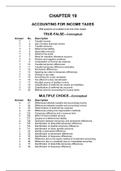Exam (elaborations)
Test Bank Chapter 19 Accounting for Income Taxes.
- Course
- Institution
CHAPTER 19 ACCOUNTING FOR INCOME TAXES IFRS questions are available at the end of this chapter. TRUE-FALSE—Conceptual Description F 1. Taxable income. F 2. Use of pretax financial income. T 3. Taxable amounts. T 4. Deferred tax liability. F 5. Deductible amounts. T 6. Deferred tax as...
[Show more]



